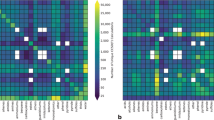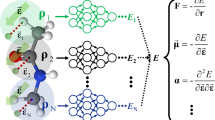Abstract
In our present work, we applied Machine Learning approaches to predict potential energy profiles for rare gas dimers as well as for the H\(_2\) molecule. We designed an Artificial Neural Network (ANN) model with one and two layers, with two to eight neurons in each layer, to predict potential energy values. We compared the ANN predicted energy values with the ab initio data and we found an excellent agreement between the actual and predicted values. The root mean squared deviation (RMSD) values for the test data are found to be 0.10, 0.22, 0.03 and 0.47 cm\({}^{-1}\) for He\(_2\), Ne\(_2\), Kr\(_2\) and Ar\(_2\), respectively. Further, we observed that the ANN method is able to fit the potential energy profile for weak van der Waals dimers as well as covalently bound molecules.
Graphical abstract
Application of machine learning approaches to predict the interaction energies for rare gas dimers is tested in this study. Our results show that Artifical Neural Network modeling is able to predict the energies for these van der Waals interactions.













Similar content being viewed by others
References
Tom M 1997 Machine learning In Machine Learning (McGraw Hill) p.1
Duda R O, Hart P E and Stork D G 2002 Pattern classification In Pattern Classification (Wiley Hill) p.2
Yu K H, Beam A L and Kohane I S 2018 Artificial intelligence in healthcareyou Nat. Biom. Eng. 2 719
Varoquaux G and Cheplygina V 2022 Machine learning for medical imaging: methodological failures and recommendations for the future npj Digital Med. 5 48
Nanni L, Ghidoni S and Brahnam S 2017 Handcrafted vs. non-handcrafted features for computer vision classification Pattern Recog. 71 158
Pavan Kumar P 2021 Deep learning for detection of text polarity in natural scene images Neurocomputing 431 1
Bhowmik T K, Ghanty P, Roy A and Parui S K 2009 SVM-based hierarchical architectures for handwritten bangla character recognition Int. J. Doc. Anal. Recognit. 12 97
Qian X, Fu Y, Xiang T, Jiang Y G and Xue X 2020 Leader-based multi-scale attention deep architecture for person re-identification IEEE Trans. Pattern Anal. Mach. Intell. 42 371
Jiang W 2021 Applications of deep learning in stock market prediction: Recent progress Expert Syst. Appl. 184 115537
Rupayan B, Raj R and U L 2020 Machine learning in chemical dynamics Resonance 25 59
Kushwaha A and Dhilip Kumar T J 2022 Benchmarking pes-learn’s machine learning models predicting accurate potential energy surface for quantum scattering Int. J. Quant. Chem. e27007
Greener J G, Kandathil S M, Moffat L and Jones D T 2021 A guide to machine learning for biologists Nat. Rev. Mol. Cell Bio. 23 40
Tang K T, Toennies J P and Yiu C L 1995 Accurate analytical he-he van der waals potential based on perturbation theory Phys. Rev. Lett. 74 1546
Cybulski S M and Toczyłowski R R 1999 Ground state potential energy curves for He\(_2\), Ne\(_2\), Ar\(_2\), He-Ne, He-Ar, and Ne-Ar: A coupled-cluster study J. Chem. Phys. 111 10520
Grisenti R E, Schöllkopf W, Toennies J P, Hegerfeldt G C, Köhler T and Stoll M 2000 Determination of the bond length and binding energy of the helium dimer by diffraction from a transmission grating Phys. Rev. Lett. 85 2284
Gdanitz R J 2001 An accurate interaction potential for neon dimer (Ne2) Chem. Phys. Lett. 348 67
Haley T P and Cybulski S M 2003 Ground state potential energy curves for he-kr, ne-kr, ar-kr, and kr2: Coupled-cluster calculations and comparison with experiment J. Chem. Phys. 119 5487
Giese T J and York D M 2004 High-level ab initio methods for calculation of potential energy surfaces of van der waals complexes Int. J. Quant. Chem. 98 388
Chen Y T, Hui K and Chai J D 2016 The van der waals interactions in rare-gas dimers: the role of interparticle interactions Phys. Chem. Chem. Phys. 18 3011
Jäger B, Hellmann R, Bich E and Vogel E 2016 State-of-the-art ab initio potential energy curve for the krypton atom pair and thermophysical properties of dilute krypton gas J. Chem. Phys. 144 114304
Deiters U K and Sadus R J 2019 Two-body interatomic potentials for He, Ne, Ar, Kr, and Xe from ab initio data J. Chem. Phys. 150 134504
Liu J, Zhai Y, Li H and McCourt F R 2022 Ab initio Morse/long-range potential energy functions plus spectroscopic and thermophysical properties of heteronuclear diatomic complexes of xenon with the rare gases J. Quant. Spectro. Radia. Trans. 285 108169
Hu Y, Zhai Y, Li H and McCourt F R 2022 Ab initio potential energy functions, spectroscopy and thermal physics for krypton-contained rare gas dimers J. Quant. Spectro. Radia. Trans. 288 108244
Behler J 2015 Constructing high-dimensional neural network potentials: A tutorial review Int. J. Quant. Chem. 115 1032
Manzhos S and Carrington T J 2021 Neural network potential energy surfaces for small molecules and reactions Chem. Rev. 121 10187
Unke O T, Koner D, Patra S, Káser S and Meuwly M 2020 High-dimensional potential energy surfaces for molecular simulations: from empiricism to machine learning Mach. Learn. Sci. Technol. 1 013001
Cui J and Krems R V 2016 Efficient non-parametric fitting of potential energy surfaces for polyatomic molecules with gaussian processes J. Phys. B: At. Mol. Opt. Phys. 49 224001
Raff L M, Malshe M, Hagan M, Doughan D I, Rockley M G and Komanduri R 2005 Ab initio potential-energy surfaces for complex, multichannel systems using modified novelty sampling and feedforward neural networks J. Chem. Phys. 122 084104
Agrawal P M, Raff L M, Hagan M T and Komanduri R 2006 Molecular dynamics investigations of the dissociation of SiO2 on an ab initio potential energy surface obtained using neural network methods J. Chem. Phys. 124 134306
Pukrittayakamee A, Malshe M, Hagan M, Raff L M, Narulkar R, Bukkapatnum S and Komanduri R 2009 Simultaneous fitting of a potential-energy surface and its corresponding force fields using feedforward neural networks J. Chem. Phys. 130 134101
Malshe M, Narulkar R, Raff L M, Hagan M, Bukkapatnam S, Agrawal P M and Komanduri R 2009 Development of generalized potential-energy surfaces using many-body expansions, neural networks, and moiety energy approximations J. Chem. Phys. 130 184102
Neese F 2022 Software update: The orca program system-version 5.0. WIREs Comput. Mol. Sci. 12 e1606
Waldrop J M, Song B, Patkowski K and Wang X 2015 Accurate ab initio potential for the krypton dimer and transport properties of the low-density krypton gas J. Chem. Phys. 142 204307
Acknowledgements
The authors would like to thank Prof. N. Sathyamurthy and R. Biswas for their valuable inputs.
Author information
Authors and Affiliations
Corresponding author
Additional information
Dedicated to Prof. S.P. Bhattacharyya on the occasion of his 75th birthday.
Special Issue on Interplay of Structure and Dynamics in Reaction Pathways, Chemical Reactivity and Biological Systems
Supplementary Information
Below is the link to the electronic supplementary material.
Rights and permissions
Springer Nature or its licensor (e.g. a society or other partner) holds exclusive rights to this article under a publishing agreement with the author(s) or other rightsholder(s); author self-archiving of the accepted manuscript version of this article is solely governed by the terms of such publishing agreement and applicable law.
About this article
Cite this article
Perepu, P.K., Mishra, B.K. & Panda, A.N. Prediction of interaction energy for rare gas dimers using machine learning approaches. J Chem Sci 135, 12 (2023). https://doi.org/10.1007/s12039-023-02131-y
Received:
Revised:
Accepted:
Published:
DOI: https://doi.org/10.1007/s12039-023-02131-y




